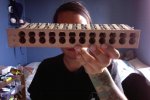Sebastian Bravo
Active member
I have a problem with this reed block... it has the same hole for both bass reeds.
So, i can't tune each reed with my tuning bellows... (I don't own the Dirk Accordion Tuner App, i just use Datuner for Android)
I had an idea of putting the reeds on another block, but that's a lot of work to tune each reed.
Any Suggestions? Just A and B are tuned...
So, i can't tune each reed with my tuning bellows... (I don't own the Dirk Accordion Tuner App, i just use Datuner for Android)
I had an idea of putting the reeds on another block, but that's a lot of work to tune each reed.
Any Suggestions? Just A and B are tuned...

